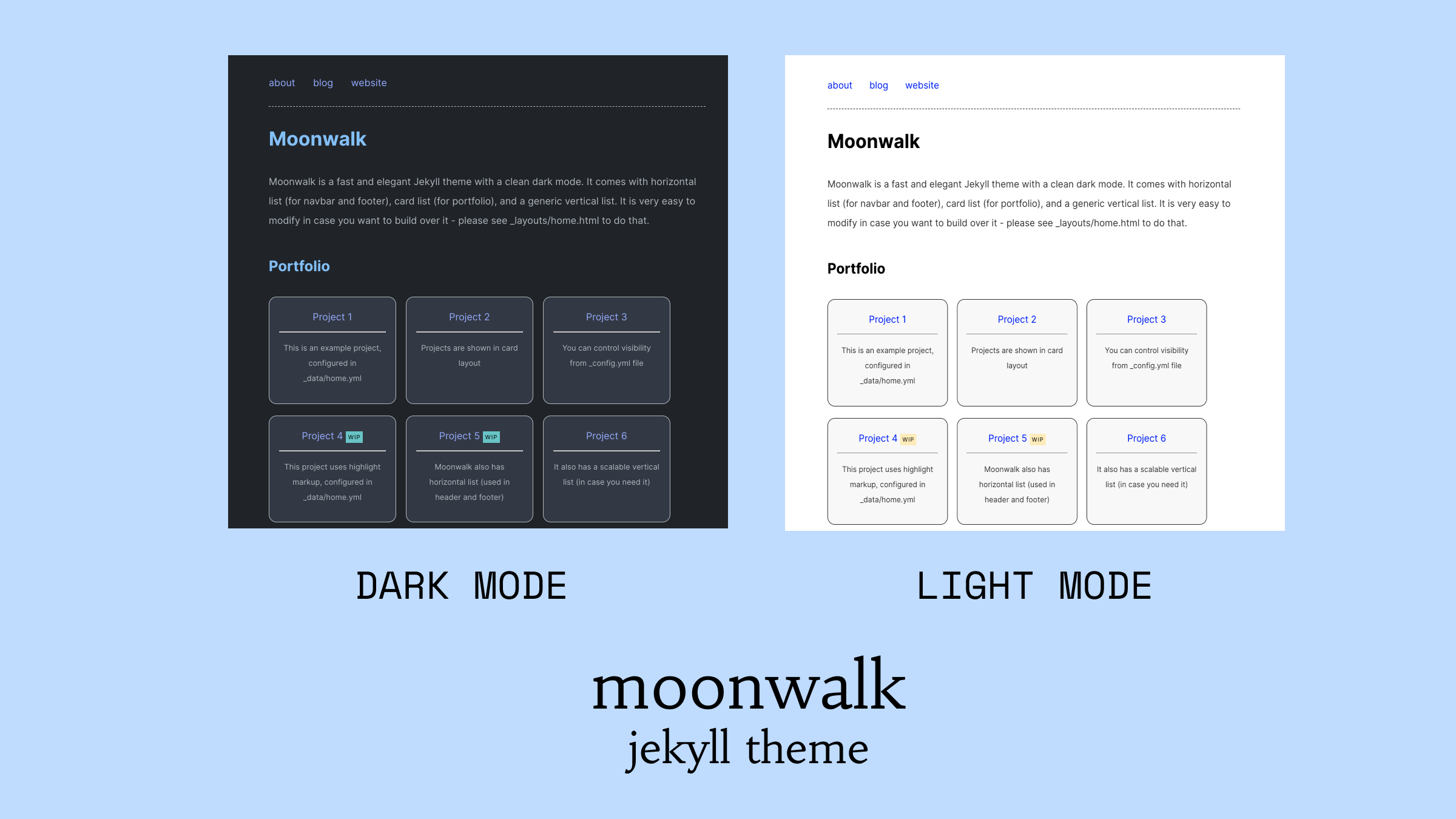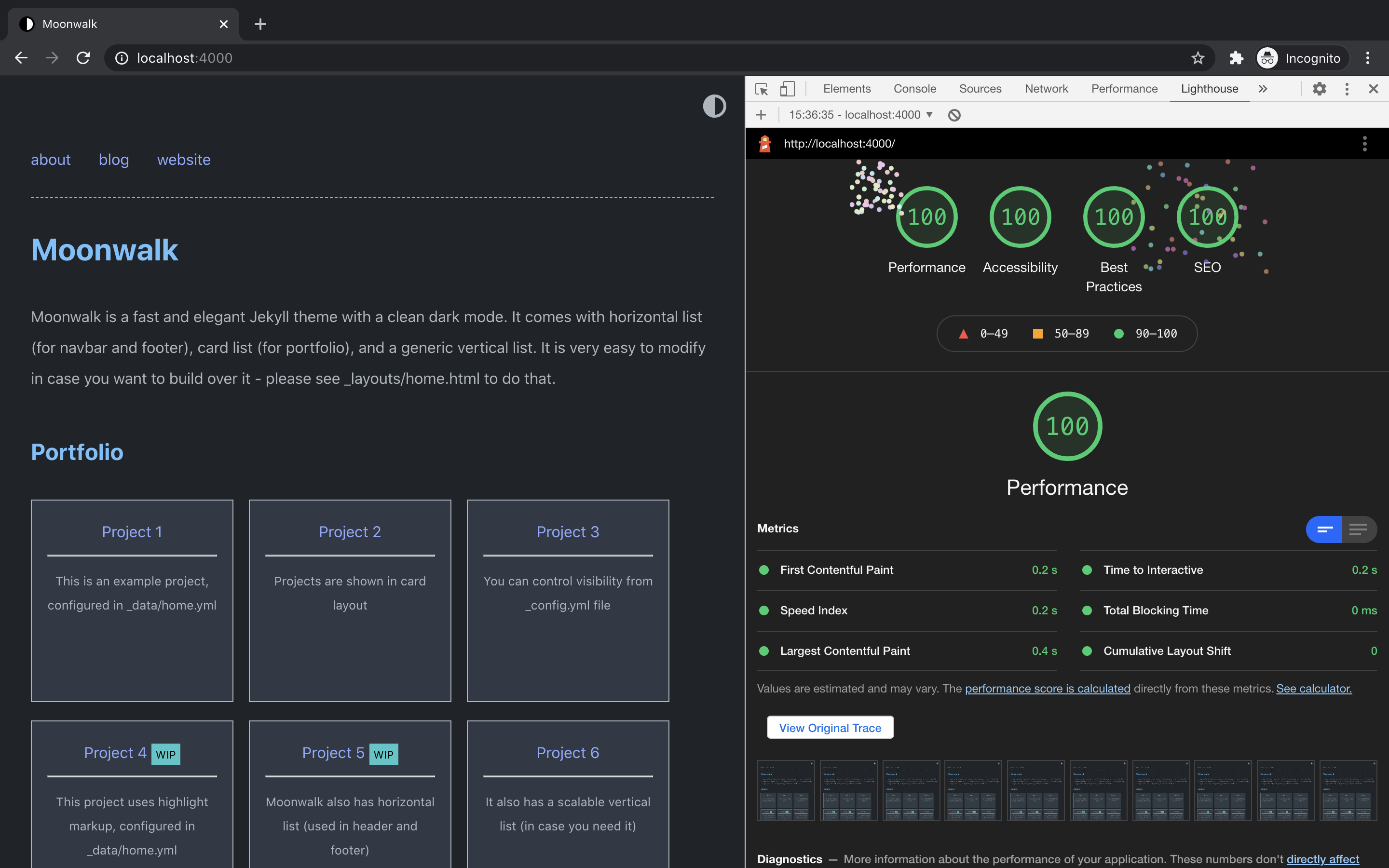Moonwalk
January 2021 • 1115 words • 7 min read
When I first built this website (abhinav.co), I used custom CSS and HTML. However, with every new project getting added, I realized I was spending more time in managing the website code than the actual website content. My subconcious mind also delayed regular blogging and demanded that I create a better website to evoke the desire to write. And like a slave without any choice I accepted.
I had some experience with Jekyll and wanted to use it again. I spent numerous hours trying to find the perfect theme which matched elegance as well as simplicity and in the end decided to write my own custom theme. It was a fun project - I enjoy UX and UI design and considered this as a great opportunity to try out my own opinions about good design.
The outcome is Moonwalk - a fast and minimalistic blog with clean dark mode.

I wanted moonwalk to be very fast and made choices to make it very performant. I took no style please! as a base, a wonderful theme with almost no CSS and customized it heavily to express my design. I avoided the temptation to add any css or javascript frameworks and explicity made the blog text heavy than image heavy. And it’s not a surprise that Moonwalk has a perfect 100/100 Lighthouse score.
If you want to see a demo - this very website is the best example of it.
Do try moonwalk for your next project.
Features
- Light & dark mode with theme switcher
- Vertical list, horizontal list, card list
- Landing page with navbar, footer, portfolio
- Fast (very minimal CSS) - 100/100 on performance, accessibility, best practices and SEO, please see Lighthouse Report for more details
- Responsive and mobile friendly
- SEO optimized (uses Jekyll SEO Tag)
- RSS feed (uses Jekyll Feed)
- Easy to extend
- Fully compatible with GitHub Pages (see GitHub Pages installation)
Lighthouse Score

Quick Installation
- Fork this repository.
cd moonwalkbin/bootstrap
Starting Server
bin/start - development server will start at http://127.0.0.1:4000
Deployment
Moonwalk can be easily deployed on all the cloud providers (AWS etc.), and on static website hosting services like Netlify & Vercel. You can also use this button to do one click deploy
If you want to use Moonwalk as a gem or use Github Pages, please see this page
Customizing
You can edit _config.yml file to customize your blog. You can change things such as the name of the blog, the author, the appearance of the theme (light, dark or auto), how dates are formatted, etc. Customizable fields should be straightforward to understand. Still, _config.yml contains some comments to help you understand what each field does.
Customize the menu
In order to add/edit/delete entries in the home page, you can copy the home.yml file inside _data folder. Through that file you can define the structure of the menu and add data for navbar, footer, portfolio or simply remove all of that and use simple blog layout. Take a look at the default configuration to get an idea of how it works and read on for a more comprehensive explaination.
The home.yml file accepts the following fields:
- Vertical list
entriesdefine a new unordered list that will contain menu entries- each entry is marked by a
-at the beginning of the line - each entry has the following attributes:
title, which defines the text to render for that menu entryurl, which can either be a URL orfalse. If it isfalse, the entry will be rendered as plain text; otherwise the entry will be rendered as a link pointing to the specified URL. Note that the URL can either be relative or absolute.post_list, which can betrueorfalse. If it is true, the entry will have all posts in the site as subentries. This is used to render your post list.entries, yes, you can have entries inside entries. In this way you can create nested sublists!
- Card list - cards are used to showcase portfolio projects. Please see
project_entriesin_data/home.ymlfile- each entry is marked by a
-at the beginning of the line - each entry has the following attributes:
titledefines the header of the carddescis the body of the cardurlis a relative or absolute link which this card can point to.highlightin case you want to highlight something, keep the text short though
- each entry is marked by a
- Horizontal list - moonwalk uses horizontal lists to create navbar and footer. Please see
navbar_entriesandfooter_entriesindata/home.ymlfile- each entry is marked by a
-at the beginning of the line - each entry has the following attributes:
titledefines the header of the cardurlis a relative or absolute link which this card can point to.
- each entry is marked by a
Pro tips
- Moonwalk has 3 in-built layouts:
- post - for content
- blog - for listing blog posts
- home - for landing page you can change your
index.mdfile to use either home or blog layout.
- It is extremely easy to tweak the color scheme.
For light mode, customize these css variables
html {
--bg: #fff;
--bg-secondary: #f8f9fa;
--headings: #000;
--text: #333;
--links: blue;
--highlight: #ffecb2; // light yellow
}
For dark mode customize these css variables
@mixin dark-appearance {
html, body {
--bg: #1f242A;
--bg-secondary: #323945;
--headings: #3D9970;
--text: #adb5bd;
--links: #91a7ff;
--highlight: #ffd43b;
};
}
Contributing
Bug reports and pull requests are welcome on GitHub.
Development
To set up your environment to develop this theme, run bundle install.
Your theme is setup just like a normal Jekyll site! To test your theme, run bundle exec jekyll serve and open your browser at http://localhost:4000. This starts a Jekyll server using your theme. Add pages, documents, data, etc. like normal to test your theme’s contents. As you make modifications to your theme and to your content, your site will regenerate and you should see the changes in the browser after a refresh, just like normal.
When your theme is released, only the files in _layouts, _includes, _sass and assets tracked with Git will be bundled. To add a custom directory to your theme-gem, please edit the regexp in moonwalk.gemspec accordingly.
Acknowledgement
This theme’s original base is no style please! theme created by Riccardo Graziosi - many thanks to him for creating a wonderful theme with nearly no css.
License
The theme is available as open source under the terms of the MIT License.
